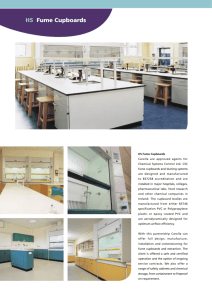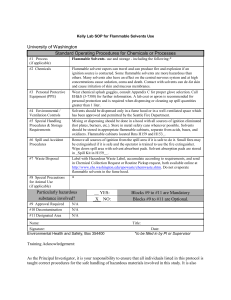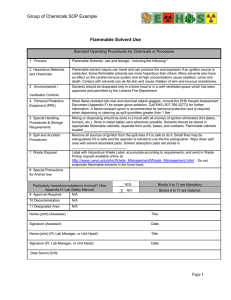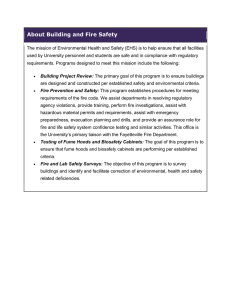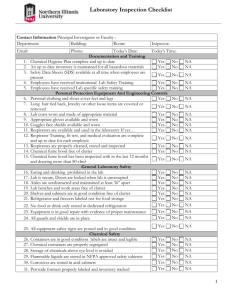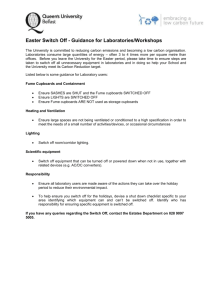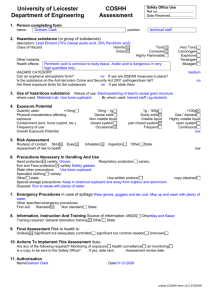Further information on safe storage of chemicals in the laboratory
advertisement
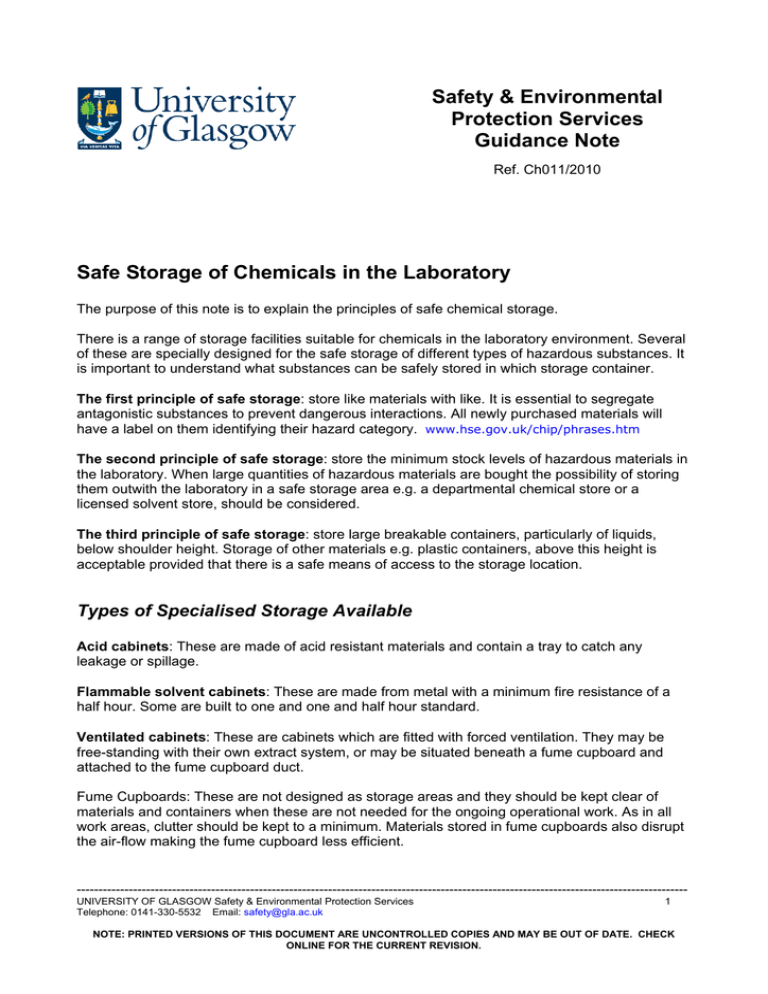
Safety & Environmental Protection Services Guidance Note Ref. Ch011/2010 Safe Storage of Chemicals in the Laboratory The purpose of this note is to explain the principles of safe chemical storage. There is a range of storage facilities suitable for chemicals in the laboratory environment. Several of these are specially designed for the safe storage of different types of hazardous substances. It is important to understand what substances can be safely stored in which storage container. The first principle of safe storage: store like materials with like. It is essential to segregate antagonistic substances to prevent dangerous interactions. All newly purchased materials will have a label on them identifying their hazard category. www.hse.gov.uk/chip/phrases.htm The second principle of safe storage: store the minimum stock levels of hazardous materials in the laboratory. When large quantities of hazardous materials are bought the possibility of storing them outwith the laboratory in a safe storage area e.g. a departmental chemical store or a licensed solvent store, should be considered. The third principle of safe storage: store large breakable containers, particularly of liquids, below shoulder height. Storage of other materials e.g. plastic containers, above this height is acceptable provided that there is a safe means of access to the storage location. Types of Specialised Storage Available Acid cabinets: These are made of acid resistant materials and contain a tray to catch any leakage or spillage. Flammable solvent cabinets: These are made from metal with a minimum fire resistance of a half hour. Some are built to one and one and half hour standard. Ventilated cabinets: These are cabinets which are fitted with forced ventilation. They may be free-standing with their own extract system, or may be situated beneath a fume cupboard and attached to the fume cupboard duct. Fume Cupboards: These are not designed as storage areas and they should be kept clear of materials and containers when these are not needed for the ongoing operational work. As in all work areas, clutter should be kept to a minimum. Materials stored in fume cupboards also disrupt the air-flow making the fume cupboard less efficient. --------------------------------------------------------------------------------------------------------------------------------------------UNIVERSITY OF GLASGOW Safety & Environmental Protection Services Telephone: 0141-330-5532 Email: safety@gla.ac.uk 1 NOTE: PRINTED VERSIONS OF THIS DOCUMENT ARE UNCONTROLLED COPIES AND MAY BE OUT OF DATE. CHECK ONLINE FOR THE CURRENT REVISION. Storage of Different Materials Acids - Small quantities can be stored safely inside a vented cabinet or even in a wooden cupboard so long as they are in a containment tray to contain any spillages. Exceptions:- a wooden cupboard cannot be used to store oxidising acids such as nitric or perchloric acids (see Oxidisers) Consideration must also be given to the effects of any acid fumes on any metal in the fittings and construction of the container. Acid chlorides and other materials which liberate acid fumes can also be stored in a similar way. Alkalis are incompatible materials which must be stored separately. Alkalis - Even although these materials are marked with a corrosive label, as are acids, they must be stored separately from acids since any accidental mixing of the concentrated materials will generate large quantities of heat and fumes. Chlorinated solvents - (e.g. chloroform, trichlorethylene) are best stored in ventilated cabinets separately from flammable solvents, because there are violent reactions when certain flammable solvents and chlorinated solvents are allowed to mix. Also, when chlorinated solvents are involved in a fire they can generate toxic gases such as phosgene. They should not be stored with alkali metals such as lithium, potassium or sodium, since any mixing may cause an explosion. Winchesters of chlorinated solvents can be stored in metal bins if ventilated storage is not available. Dangerous drugs and medicines - should be stored in locked cupboards. If it is necessary to store them at low temperatures the fridge or freezer used should be fitted with a lock. Flammable solvents - (e.g. alcohols, toluene, hexane etc.) should only be stored in specialised flammable solvent containers. These are available commercially and consist of a cupboard or bin with containment for any spilled solvent. The construction should have at least half hour fire resistance. They should be properly labelled e.g. "Highly flammable no naked flames". Chlorinated solvents should not be stored in a flammable solvent container. Oxidising agents (such as peroxides, perchlorates and nitrates) must never be stored with flammable solvents since fires and explosions can result after any spillage, even without a naked flame or heat. The cabinet or bin must be kept securely closed at all times to prevent spread of fire. The amount of flammable solvent, including waste flammable solvent stored in a lab area should not exceed 50 liters in total. Flammable solvents are recommended not to be stored in fume cupboards since the airflow will fan any fire and may also spread the fire to other parts of the building via the ventilation ducting. The ventilation openings in a ventilated cabinet would also allow a fire in the lab to be drawn into the cabinet. Noxious chemicals - Ventilated cabinets are designed to safely hold chemicals which give off noxious fumes and smells. These fumes are sucked away by forced ventilation. Often these are located under fume cupboards and use the same extract system as the fume cupboard. Feestanding units are also available with their own ventilation system, these cabinets should be used to store materials such as mercaptans, lachrymators and amines which have a strong smell. If you do not have ventilated cabinet, the containers of these noxious materials can be stored in sealed secondary containers which should only be opened in a fume cupboard. On occasions fume cupboards can be used to store such materials provided such fume cupboards are used solely for this purpose and not used to undertake experimental activity. --------------------------------------------------------------------------------------------------------------------------------------------UNIVERSITY OF GLASGOW Safety & Environmental Protection Services Telephone: 0141-330-5532 Email: safety@gla.ac.uk 2 NOTE: PRINTED VERSIONS OF THIS DOCUMENT ARE UNCONTROLLED COPIES AND MAY BE OUT OF DATE. CHECK ONLINE FOR THE CURRENT REVISION. Oxidisers - (e.g. peroxides, perchlorates and nitrates) are best stored separately from other materials. Ideally, they should be stored in a bin or cabinet made from metal or other non-organic material. They should not be stored where they can come in contact with wooden shelves or paper. Perchloric acid is especially hazardous and is best stored standing in a tray filled with sand within a cabinet or bin. Poisons - Section 7 of the Poisons Act 1972 (revised 2002) lists toxic substances known as Schedule 1 Poisons. This has been amended by various Orders of Parliament. This list includes most of the well known poisons such as arsenic, cyanide, strychnine. They must be stored in a locked cupboard and a list kept of the contents. Any poison removed must be signed for. It would be good laboratory practice to take the same care in the storage of other highly toxic substances even although they do not appear on Schedule 1. Chemical suppliers should indicate whether a substance is a Schedule 1 poison at the time of purchase and will normally have a special order procedure for such materials. Other materials can be kept in normal cupboards or in ventilated cabinets and fridges according to their other properties. Advice on specific storage issues is available from Safety & Environmental Protection Services, Ext. 5532. --------------------------------------------------------------------------------------------------------------------------------------------UNIVERSITY OF GLASGOW Safety & Environmental Protection Services Telephone: 0141-330-5532 Email: safety@gla.ac.uk 3 NOTE: PRINTED VERSIONS OF THIS DOCUMENT ARE UNCONTROLLED COPIES AND MAY BE OUT OF DATE. CHECK ONLINE FOR THE CURRENT REVISION.
